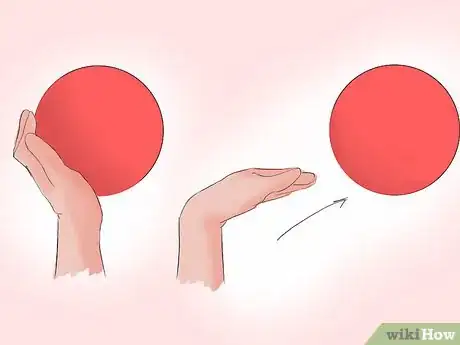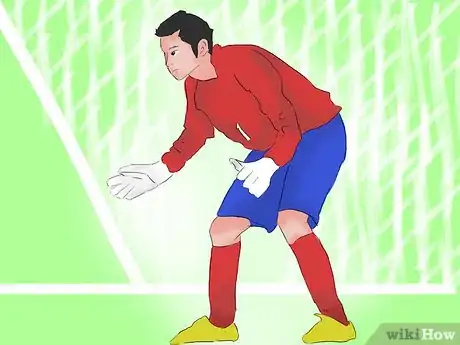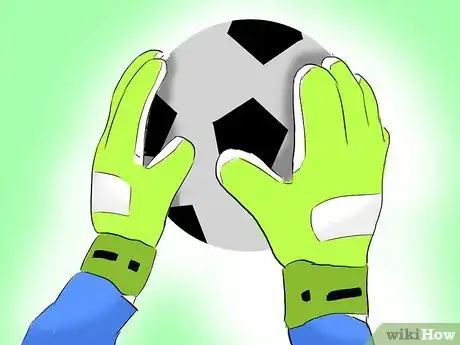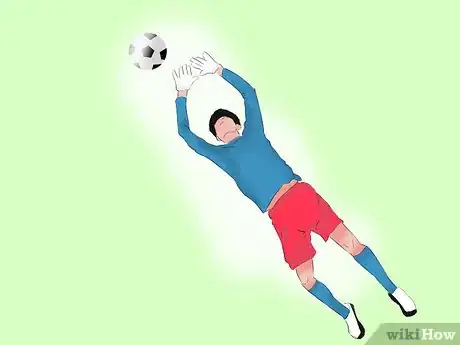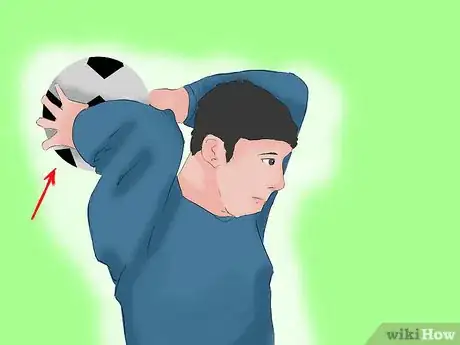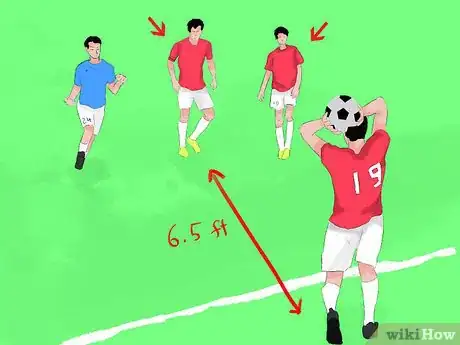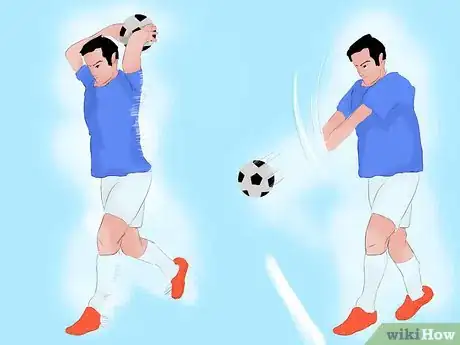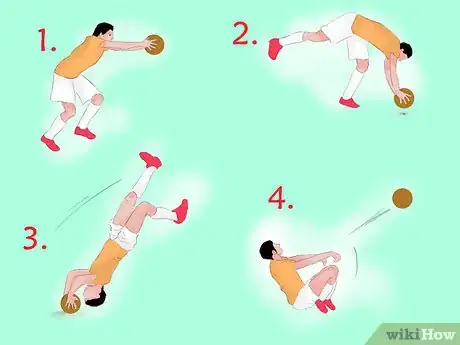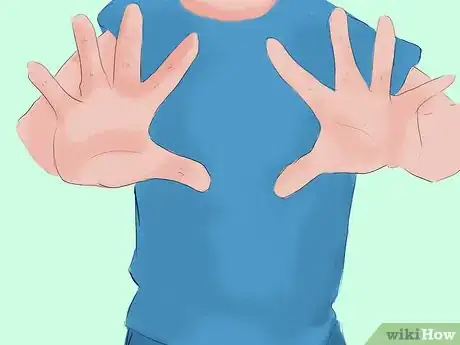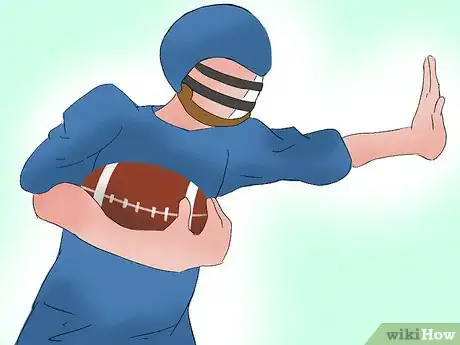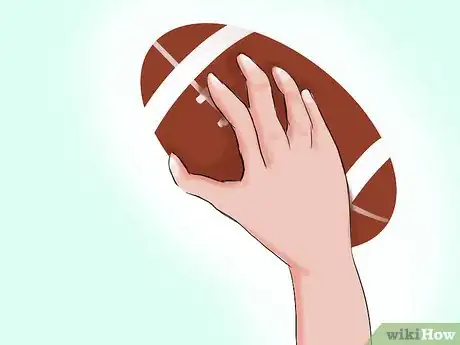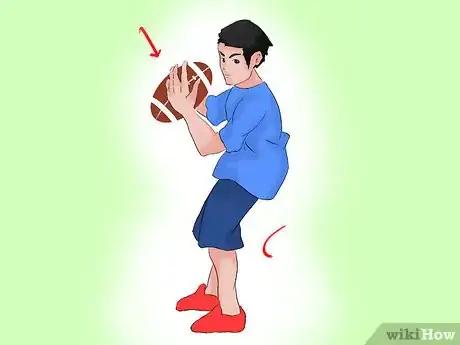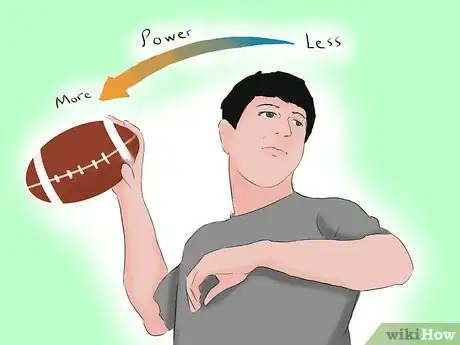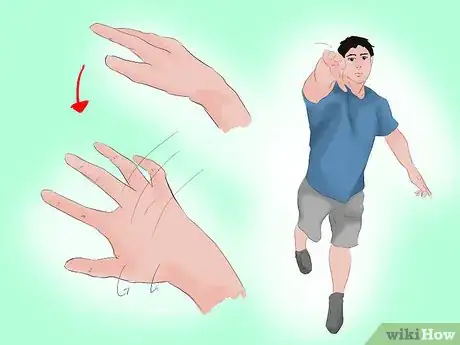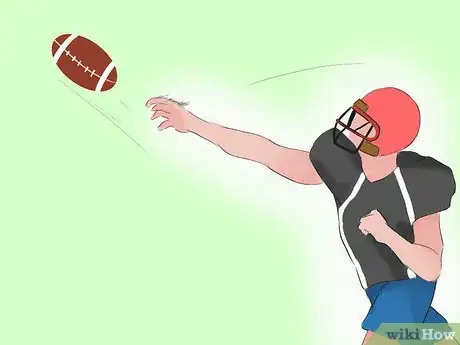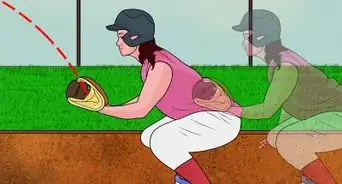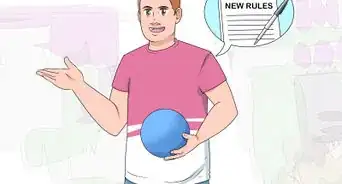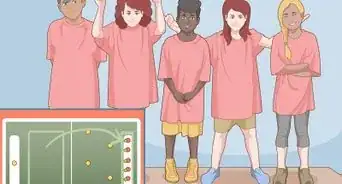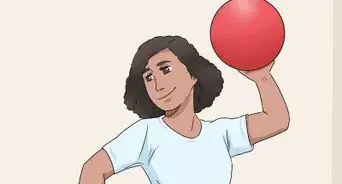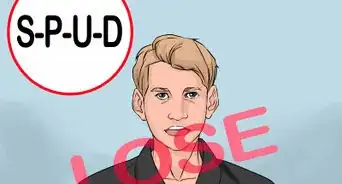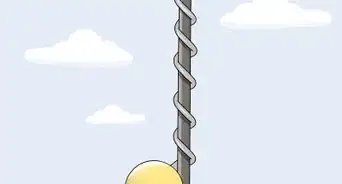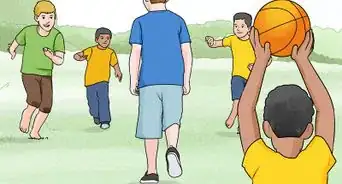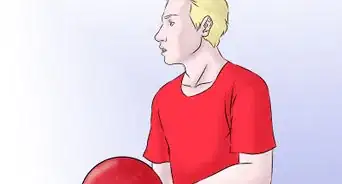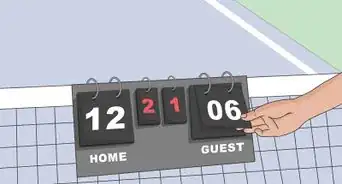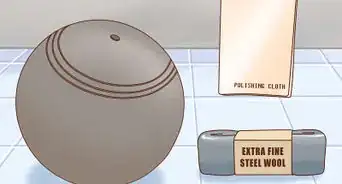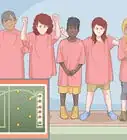This article was co-authored by wikiHow Staff. Our trained team of editors and researchers validate articles for accuracy and comprehensiveness. wikiHow's Content Management Team carefully monitors the work from our editorial staff to ensure that each article is backed by trusted research and meets our high quality standards.
There are 18 references cited in this article, which can be found at the bottom of the page.
This article has been viewed 134,168 times.
Learn more...
Depending on the type of ball you are throwing and the distance the ball will be traveling, the mechanics of your throw can have a big effect on the outcome. The best results can be achieved with proper form and consistent technique. No matter if you're trying to throw a normal ball, a soccer ball during a game, or a football, by using the right stance and following through with your body, you'll stand the best chance of getting the ball exactly where you aim.
Steps
Catching and Throwing a Regular Ball
Catching a Regular Ball
-
1Align yourself with the ball.[1] You'll need to move your body so that you are in catching distance of the ball, but you should also try to line up your eyes with the ball so you can clearly see it incoming. Keep your eyes focused on the ball, and:
- Adopt a wide stance to keep your balance when catching. It can help to keep one of your feet a little in front of the other.
-
2Meet the ball with your hands. As the ball moves through the air toward you, you're going to need to reach out with your hands to grab it mid-flight. Do not tense your hands; this can lead to pain from the impact. Instead:
- Keep your hands wide-spread.
- Keep your fingers relaxed.
- Reach toward the ball.[2]
Advertisement -
3Grasp the ball. Depending on the speed at which the ball was thrown and the amount of spin on it, you might use either or both of your hands. For lobs and light throws, simply follow the ball with your eyes while reaching with your hands, and:
-
4Cushion the impact of the ball. This is especially important for cannon-throws or balls thrown at high speeds, which can hurt your hand. As you trap the ball with your fingers, allow your hand to follow the motion of the ball and ease it to a stop, as opposed to catching and stopping it immediately where it meets your hand.[5]
- Keep your knees bent and your stance wide to improve balance when catching.
- Bend your arms at the elbows to help reduce the force of the ball's impact.
Throwing a Regular Ball
-
1Stand so that you're ready to throw. How you stand when throwing a ball can dramatically affect the outcome of your throw. When trying to throw a normal sized ball, you can achieve best results by standing so that:
-
2Position your arm to throw the ball. Holding the ball in your hand with your body in the proper stance, hold the ball upwards, so that your elbow is about the same height as your shoulder. At this point, your arm should form an L-shape.[8]
-
3Practice your wrist motion. The motion of your throw should flow smoothly from start to finish. To prevent yourself from making the error of locking up your wrist, practice using it as part of your throw by holding the ball in your hand and then:[9]
- Bend only your wrist backward.
- Snap your wrist forward.
- Allow your elbow straighten out.
- Release the ball as you straighten your arm.[10]
-
4Add a windup to your throw. A windup is simply where you reach farther back when throwing a ball while stepping through with your leading foot to add more power and distance. Get in throwing stance, and then hold the ball in your hand straight up while keeping your elbow and shoulder at about the same height. From that position:
- Reach slightly backwards while keeping the ball facing your target.
- Raise your leading foot slightly at the backmost part of your reach.
- Shift your weight forward to your front foot.
- Follow through with your arm and wrist.
- Release the ball at the frontmost part of your throw, as your wrist is snapping forward.[11]
Catching and Throwing a Soccer Ball
Catching a Soccer Ball (goalkeepers)
-
1Meet the ball with your hands as soon as possible. A goalkeeper's greatest advantage in soccer is his ability to touch, catch, and punch the ball. By making sure your hands get to the ball as soon as possible, you improve your chances of catching or punching the ball away.
- A foot block might be necessary sometimes, but this is often a less controlled. A goalie should use his advantage (his hands) to his benefit whenever possible.[12]
-
2Absorb the force of shots on net through proper form. Professional soccer players and coaches call this having "soft hands." This means that a goalie must be able to engage his arms, legs, and back muscles to cushion balls shot on net. By absorbing the force of the ball, you stand a better chance of holding onto it. You should:
- Keep elbows at least slightly bent, even when reaching for the ball.
- Be ready to bend back at the waist for high kicks at fast speeds.
- Always move forward toward the ball, to cut down on the shooting angles of the striker.[13]
-
3Make use of the "W" catch. This style of catching is also called the contour catch. It gets its name from the W shape a goalkeeper's hands should take when catching, with thumbs meeting behind the center of the ball and the hands slightly off to the side.[14]
- Goalkeepers who have smaller hands should bring their wrists close together and their thumbs almost parallel to protect the ball from slipping through their hands.
-
4Catch the ball in the air when shots go high. You never know when a ball is going to sail through the air at the net, so anticipate the ball by bending your knees, keeping your eyes attentive, and holding your hands open and ready. When you jump to catch an high shot on the net, you should:
- Jump to meet the ball at the highest point possible.
- Raise your knee closest to pressuring attackers, being careful not to injure any oncoming players.[15]
-
5Catch ground balls with proper body blockage. Ground balls can give the illusion of a simple catch, which can open you up to letting a ball through your legs. Experts agree, you can prevent letting a ball past you by getting your body behind the ball. This way, if there is, for example, a lot of spin that tears the ball loose from your grasp, it will hit your body and either be stopped or ricochet away from the net.
-
6Guard the ball to prevent drops. When offensive members of the other team are charging in for a goal, you can be jostled around enough to lose your grip of the ball, especially if you are holding it away from your body. By cradling the ball to your body with both arms and hands, you stand a better chance of maintaining possession and keeping hold of the ball.[16]
Throwing a Soccer Ball
-
1Know the rules for a throw-ins. While playing a game of soccer, players are expected to follow strict rules regarding body position and throwing technique when throwing in a ball kicked out of bounds. Most serious soccer leagues use FIFA throw-in rules, which state:
- The ball must be thrown from the point where it left bounds.
- You must throw the ball using both hands.
- The ball must be thrown from behind the head.
- Both feet must be touching the ground at the moment of release.
- You may not come in-bounds, but may step on the field boundary line.
- The thrower may not touch the ball until it has touched another player.
-
2Pick a teammate you will throw the ball to. Survey the state of the field and look for any teammates who are maneuvering into a strong position to receive the ball. Be careful not to throw the ball at a player who is offsides; this will result in a penalty.
- Players must be at least two meters (6.5 feet) away from the thrower before he throws.
- If your team is on the attack and in position while your opponents are scrambling, a quick throw in is sometimes ideal.
- You can also throw the ball back to your goalkeeper if you don't have many options for where to throw, though in this case a goalkeeper will have to play the ball with his feet.[17]
-
3Throw the ball while stationary to prevent yourself from fouling. To prevent yourself from lifting your foot while throwing, or from forgetting to reach the ball fully behind your head, you may want to make your normal throw stationary. To perform this throw, you should:
- Position your feet shoulder width apart.
- Hold the ball with both hands on either side of the ball.
- Point your elbows out to the side to increase the power of your throw.
- Reach your throw behind your head.
- Follow through with your arms and body.
- Raise your heel to keep your balance, if necessary, without losing ground contact with both feet.[18] [19]
-
4Take a running throw for longer distances. Many advanced players use this tactic. By running toward the throw-in point, you can build momentum and throw the ball farther than you would normally. However, this style of throw is prone to raised feet or missteps, and can result in penalties. To take a running throw in soccer, you should:
- Take several steps away from the boundary line of the field.
- Hold the ball with both hands, as normal.
- Reach the ball behind your head.
- Run toward the throw-in location.
- Plant your lead foot outside the sideline boundary to come to a stop.
- Throw the ball the moment you stop.
- Drag your trailing foot to prevent fouls.
-
5Try your hand at the difficult handspring throw. These kinds of throw-ins are rare due to their difficulty in executing. A handspring throw will require you to perform a forward flip while holding the soccer ball, throwing the ball the moment both your feet touch the ground.[20]
- While performing this throw, it's especially important for you to stay off the field so a penalty is not called.
- Avoid attempting this throw in slick conditions; rain can result in you slipping and hurting yourself or receiving a penalty.[21]
Catching and Throwing a Football
Catching a Football
-
1Position your hands to catch the ball. The most reliable way to catch a football is to bring your hands in front of you to form a diamond shape. You can imitate this hand position if you:
- Bring your hands in front of your body.
- Spread your hands wide.
- Nearly touch the tips of your pointer fingers and thumbs.[22]
-
2Use the "window" in your hands as a sight.[23] The space between your pointer fingers and thumbs should form a diamond shaped window. Look through this window to help position your hands in line with the oncoming football.
-
3Relax and spread wide your hands.[26] Tensing your hands to try to immediately stop the ball when you catch it can result in pain or even injury. Allow your hands and elbows to follow the motion of the football, easing it to a stop.
- By keeping your fingers spread and your hands "big," you increase surface area and make the ball easier to catch.
-
4Employ your entire arm for aerial catches. Raising your arms stiffly to catch a ball dropping in on you will likely result in a fumble. Keep your arms bent, even when extending to catch a high pass. This will lessen the force of impact and improve your chances of catching.[27]
-
5Tuck the ball to your chest to maintain possession.[28] Defenders will try whatever legal move they can to take the ball from your possession. You'll need to protect the ball once you have caught it by tucking it to your chest, firmly holding it between your body and arm.
Throwing a Football
-
1Grip the ball in the way most comfortable for you. There is no standard grip for holding a football, so the most natural feeling one is the one you should use. Generally, when throwing a football, you should:
- Grip the back half of the football so that you can feel two or three laces.
- Hold the ball close to your chest.
-
2Keep your knees bent and lower body engaged. A slight bend in your knees will engage your lower body more so you are prepared to throw at a moments notice. Some quarterbacks further recommend distributing your weight slightly more towards your back leg, allowing you to follow through with more body weight for a better throw.[29]
- Your feet should also be shoulder width apart to create a strong, balanced stance that is ready to throw.[30]
-
3Cock your arm back and grip with your fingers. Your throw will begin by you pulling the ball back high, so that your elbow is a little above your shoulder and the bottom of the ball about in line with your ear. Use your fingers to grip the ball and allow an air pocket to from between palm and ball.[31]
-
4
-
5Coordinate your body motion for best follow through. Draw your non-throwing hand down to your hip and then out and away from your body to begin rotating your hips. Now square your shoulders so you are facing your target and pivot so your front foot points straight ahead.[34]
-
6Follow through with your throwing hand and release. The motion of your left hand, rotation of your hips, and opening of your shoulders should have caused a follow through motion in your cocked and ready throwing arm. Allow that arm to:
-
7Continue your throwing motion until the range is fully completed.[37] After you have launched the ball from your hand, you should continue the motion of your release. Follow it until your throwing hand reaches the area of your left pocket to train yourself in a consistent, smooth release.
Community Q&A
-
QuestionCan I use a tennis ball for this?
 Community AnswerYes, any type of ball can be used.
Community AnswerYes, any type of ball can be used. -
QuestionWhat if I keep getting hit in the head by the ball?
 Community AnswerTry wearing a helmet until you improve with catching the ball.
Community AnswerTry wearing a helmet until you improve with catching the ball. -
QuestionHow do I throw and catch a small ball?
 Community AnswerPractice makes perfect. Keep your eye on the ball as someone throws it to you. Ask a family member or friend if they would help you practice. Start by catching the ball from short distances, then gradually have the person move farther away.
Community AnswerPractice makes perfect. Keep your eye on the ball as someone throws it to you. Ask a family member or friend if they would help you practice. Start by catching the ball from short distances, then gradually have the person move farther away.
Warnings
- Certain games require you to execute special kinds of throws, or have specific rules for throwing. If you are unsure of the rules or technique, you should ask a coach or teammate.⧼thumbs_response⧽
References
- ↑ http://www.nicurriculum.org.uk/docs/foundation_stage/areas_of_learning/physical_development/FMS_Catch.pdf
- ↑ http://www.nicurriculum.org.uk/docs/foundation_stage/areas_of_learning/physical_development/FMS_Catch.pdf
- ↑ http://www.nicurriculum.org.uk/docs/foundation_stage/areas_of_learning/physical_development/FMS_Catch.pdf
- ↑ http://www.boxofideas.org/ideas/practical-skills-at-home/hobbies-and-leisure/ball-skills-normal-development/ball-skills-catching-throwing/
- ↑ http://www.everythingmaths.co.za/science/grade-12/02-momentum-and-impulse/02-momentum-and-impulse-06.cnxmlplus
- ↑ http://www.todaysparent.com/family/activities/how-to-throw-a-ball/
- ↑ https://www.youtube.com/watch?v=W8Wosz4XaRU
- ↑ http://www.todaysparent.com/family/activities/how-to-throw-a-ball/
- ↑ http://www.qcbaseball.com/skills/throwing-a-baseball.aspx
- ↑ http://www.todaysparent.com/family/activities/how-to-throw-a-ball/
- ↑ http://www.qcbaseball.com/skills/throwing-a-baseball.aspx
- ↑ http://www.jbgoalkeeping.com/catch.html
- ↑ http://www.jbgoalkeeping.com/catch.html
- ↑ http://www.jbgoalkeeping.com/catch.html
- ↑ http://www.jbgoalkeeping.com/catch.html
- ↑ http://www.jbgoalkeeping.com/catch.html
- ↑ http://soccerhelp.com/Throw.shtml
- ↑ http://soccerhelp.com/Throw.shtml
- ↑ http://www.soccerpilot.com/technique/articles/soccer-technique-006.html
- ↑ http://www.active.com/soccer/articles/the-art-of-the-flip-throw
- ↑ http://www.active.com/soccer/articles/the-art-of-the-flip-throw?page=2
- ↑ http://online.wsj.com/public/resources/documents/Chapter02.pdf
- ↑ http://online.wsj.com/public/resources/documents/Chapter02.pdf
- ↑ http://www.ducksters.com/sports/football/catching_a_football.php
- ↑ http://www.functionalps.com/blog/2010/03/26/fundamentals-catching-the-football/
- ↑ http://online.wsj.com/public/resources/documents/Chapter02.pdf
- ↑ http://online.wsj.com/public/resources/documents/Chapter02.pdf
- ↑ http://www.ducksters.com/sports/football/catching_a_football.php
- ↑ http://www.primermagazine.com/2012/learn/how-to-throw-a-football-with-a-perfect-powerful-spiral-a-visual-guide
- ↑ http://www.ducksters.com/sports/football/throwing_a_football.php
- ↑ http://www.primermagazine.com/2012/learn/how-to-throw-a-football-with-a-perfect-powerful-spiral-a-visual-guide
- ↑ http://gearpatrol.com/2014/01/31/guide-to-life-throw-perfect-spiral/
- ↑ http://www.artofmanliness.com/2012/11/19/how-throw-a-spiral-football/
- ↑ http://www.primermagazine.com/2012/learn/how-to-throw-a-football-with-a-perfect-powerful-spiral-a-visual-guide
- ↑ http://gearpatrol.com/2014/01/31/guide-to-life-throw-perfect-spiral/
- ↑ http://www.primermagazine.com/2012/learn/how-to-throw-a-football-with-a-perfect-powerful-spiral-a-visual-guide
- ↑ http://www.ducksters.com/sports/football/throwing_a_football.php
About This Article
To catch a ball, start by aligning yourself with the ball so it's coming right to you. Then, adopt a wide stance so you can maintain your balance when you catch it. When the ball is within grabbing distance, reach out with an open hand and squeeze your fingers around the ball to trap it. Make sure you keep your eye on the ball at all times and reach your hands out before it reaches you to avoid getting hit. Additionally, you may want to try catching the ball with 2 hands at first until you get the hang of it. To learn how to catch different types of balls, like soccer balls and footballs, keep reading!






